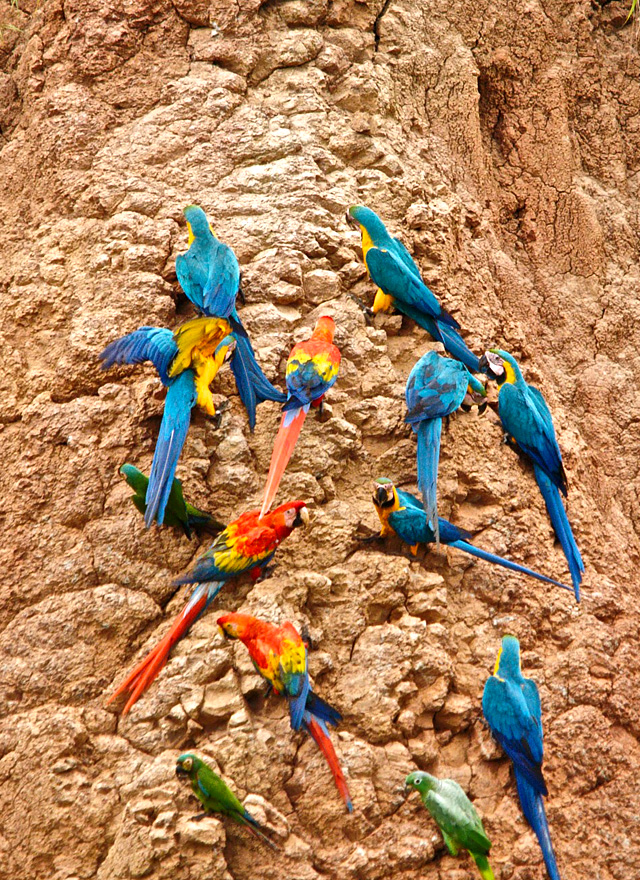
Macaws enjoying the clay lick at the Tambopata Research Center in Peru. Photo © Brian Ralphs, licensed Creative Commons Attribution.
The daily work schedule often starts early with 4am trips to monitor the parrots at the clay lick or 5am walks to look for foraging parrots.Short-term volunteers are trained to identify all the local parrots by sight and become experts at clay lick monitoring and macaw nest observation with video camera systems (November-March). They also assist with data entry. Due to the short length of stay, volunteers will have only minimal involvement in activities requiring higher training levels, like parrot censuses and tree climbing. Weather is hot year-round, and November-March is the wet season. Although volunteers come to work on the macaw project, they also have good chances of spotting five kinds of monkeys, capybaras, caimans, agoutis, peccaries, and, if they are very lucky, perhaps a jaguar, tapir, or harpy eagle.Ten- to twelve-hour workdays are common. The daily work schedule often starts early with 4am trips to monitor the parrots at the clay lick or 5am walks to look for foraging parrots. Breakfast is at 7:30am, followed by more activities 9am-1:30pm. After lunch, around 3pm, volunteers are usually back out in the forest, conducting parrot counts, climbing nests, looking for foraging parrots, and so on. On rainy days volunteers work on data entry, or clean and maintain gear at the house.
Conducting research in a protected area in Peru requires a research permit from the office of Servicion Nacional de Areas Naturales Protegidas (SERNANP) in Puerto Maldonado. TMP applies for this permit once per year, and volunteer information is submitted at that time. TMP can add up to three appendices per year with additional volunteer names, but because of the complicated process, volunteers should apply as far in advance of their travel dates as possible (four months out at a minimum).
Near Puerto Maldonado, Amazon, Peru
Application Process: To apply, volunteers must send an email with a letter of interest, their résumé/cv, email addresses for at least three references, and a date range of availability. Volunteers should be age 18 or older.
Cost: US$30 placement fee, plus a US$40 daily fee. Housing is included, as is transportation to the lodge from Puerto Maldonado.
Placement Length: 12-30 days for short-term volunteers
Language Requirements: None, although Spanish is always helpful.
Housing: Accommodations are in the rustic researcher area, in shared rooms. There are running water and flush toilets, but showers are cold water only. Meals are with lodge staff; lunch and dinner are typically Peruvian fare, such as chicken and rice. There is limited electricity and Internet.
Operating Since: 1989
Number of Volunteers: 33 in 2012
Excerpted from the First Edition of Moon Volunteer Vacations in Latin America.